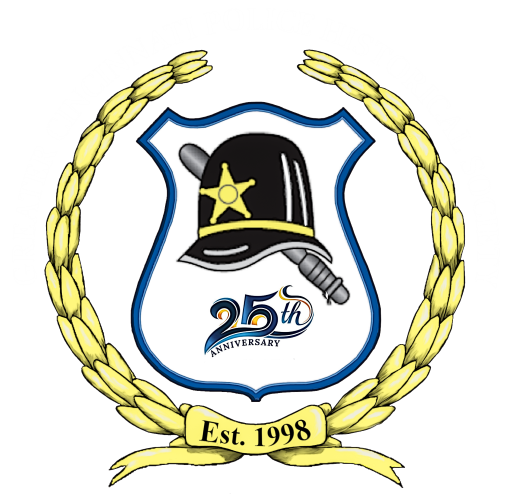
Age: 48
Served: 9 years
September 16, 1907 to July 3, 1916
OFFICER
During February 1906, Arthur nearly lost his life when a wagon loaded with newspapers was struck by a Cincinnati, Hamilton, and Indianapolis train. The horse was killed, the wagon demolished, and he was thrown thirty feet, but he survived his injuries.
Our first indication of his employment as a Hamilton Patrolman was when he arrested a well-known arsonist and drug user during July 1911. At the time, the Department consisted of 36 Patrolmen. A popular officer, by 1914 he was elected President of the Hamilton Police Mutual Aid Society.
During 1915, he was assigned to act as Inspector when Inspector John H. DeArmond was terminated. On September 2, 1915, he was permanently promoted to the position.
MURDERER
Walter Balser was born during October 1883 to Jacob Bolser and Jane Kisskaden Balser. His abuse of women began as early as 14-years-old in 1898 when Maggie Orr complained he assaulted her due to a feud in the First Ward. He was living with his parents in 1900 and working as a laborer for a safe manufacturer. His father died when he was 21 in 1905.
INCIDENT
On July 1, 1916, Patrolman Yarnell was called to Caldwell Street for a report of an intoxicated Walter Balser abusing his wife. Patrolman Yarnell attempted to arrest the powerfully built Balser and several officers were needed to overcome his resistance.
While in the search room at the Hamilton Police station, at 6:15 p.m., Dr. Zerfass tried to tend the wounds that Balser sustained during his arrest. When Inspector Walke ordered Balser to sit in a chair, Balser suddenly punched him knocking him unconscious. As he fell, Balser flung himself on top of the Inspector. Inspector Walke’s head struck the cement floor, fracturing his skull. Balser had to be pulled off by Dr. Zerfass. He boasted to Dr. Zerfass, “Did you see how I handled that guy?”
Inspector Walke was carried into the Mayor’s office bleeding from the nose and ears. Dr. Edward Cooke was called, and he ordered the inspector to Mercy Hospital.
Balsar was taken to the County Jail for his own safety.
DEATH
His condition worsened before arriving at the hospital and steadily thereafter until Monday morning, July 3, 1916, when all hope of a recovery was given up and the family was called to the hospital.
Inspector Walke never regained consciousness and died on July 3, 1916 at 3:20 p.m. from the fractured skull and concussion of the brain. Inspector Walke was the first line of duty death in the Hamilton Police Department. Balser was charged with Murder.
Inspector Walke left a wife, Minnie A. Walke, and children, Mark Walk (21), William Wilmer Walk (19), and Hardeman Martin Walke (16). Funeral services were conducted at his home at 713 Central Avenue by Rev. C. R. Sine of the High Street Church of Christ. Following which his remains were escorted to Greenwood Cemetery by a detail of police, the Eagles, and the Ben Hurs.
JUSTICE
Judge Cunningham presided over Balser’s preliminary hearing, bound him over to the Grand Jury, and remanded him back to jail without bond. Balser petitioned the judge for another bond hearing and on October 5, 1916 the judge refused. The Grand Jury returned an indictment for 2nd Degree Murder.
His first trial began on November 28, 1916. On December 1st, the jury was hopelessly deadlocked with 9 wanting a finding of Guilty of Manslaughter. On December 15, another trial began. On December 18, 1916, within an hour of retiring, the jury found Balser guilty of Manslaughter. On January 18, 1917, Judge Murphy sentenced Balser to 1 to 20 years in the penitentiary. By 1918 he was already out of prison, living in Dayton, and working as a machinist when is daughter died of pneumonia in Dayton. In 1929, at 44-years of age, he was injured in an auto accident on Millville Road and Edgewood. Helen Eigel charged him with abusing her on October 6, 1930 and he was charged with public intoxication and disorderly conduct.
EPILOGUE
Inspector Walke’s youngest son, Martin, was shot and killed in another homicide in Hamilton 5 years later in 1921.
Mrs. Walke died in 1933.
However, we know that great, great, great grandchildren survive him.
If you know of any information, artifacts, archives, or images regarding this officer or incident, please contact the Greater Cincinnati Police Museum at Memorial@Police-Museum.org.
© This narrative was further researched and revised July 2, 2021 by Cincinnati Police Lieutenant Stephen R. Kramer (Retire), Greater Cincinnati Police Historical Society President, assisted by researcher Joyce Meyer, Price Hill Historical Society. All rights are reserved to them and the Greater Cincinnati Police Museum.


